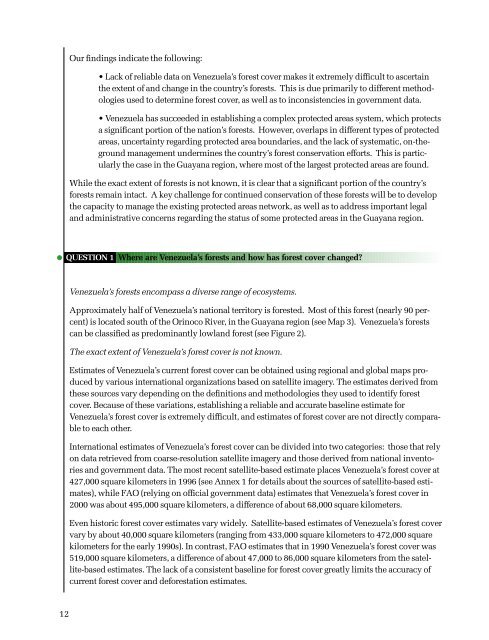Usar pâgs xvii-134 - ResearchGate
Usar pâgs xvii-134 - ResearchGate
Usar pâgs xvii-134 - ResearchGate
You also want an ePaper? Increase the reach of your titles
YUMPU automatically turns print PDFs into web optimized ePapers that Google loves.
Our findings indicate the following:• Lack of reliable data on Venezuela’s forest cover makes it extremely difficult to ascertainthe extent of and change in the country’s forests. This is due primarily to different methodologiesused to determine forest cover, as well as to inconsistencies in government data.• Venezuela has succeeded in establishing a complex protected areas system, which protectsa significant portion of the nation’s forests. However, overlaps in different types of protectedareas, uncertainty regarding protected area boundaries, and the lack of systematic, on-thegroundmanagement undermines the country’s forest conservation efforts. This is particularlythe case in the Guayana region, where most of the largest protected areas are found.While the exact extent of forests is not known, it is clear that a significant portion of the country’sforests remain intact. A key challenge for continued conservation of these forests will be to developthe capacity to manage the existing protected areas network, as well as to address important legaland administrative concerns regarding the status of some protected areas in the Guayana region.• QUESTION 1 Where are Venezuela’s forests and how has forest cover changed?Venezuela’s forests encompass a diverse range of ecosystems.Approximately half of Venezuela’s national territory is forested. Most of this forest (nearly 90 percent)is located south of the Orinoco River, in the Guayana region (see Map 3). Venezuela’s forestscan be classified as predominantly lowland forest (see Figure 2).The exact extent of Venezuela’s forest cover is not known.Estimates of Venezuela’s current forest cover can be obtained using regional and global maps producedby various international organizations based on satellite imagery. The estimates derived fromthese sources vary depending on the definitions and methodologies they used to identify forestcover. Because of these variations, establishing a reliable and accurate baseline estimate forVenezuela’s forest cover is extremely difficult, and estimates of forest cover are not directly comparableto each other.International estimates of Venezuela’s forest cover can be divided into two categories: those that relyon data retrieved from coarse-resolution satellite imagery and those derived from national inventoriesand government data. The most recent satellite-based estimate places Venezuela’s forest cover at427,000 square kilometers in 1996 (see Annex 1 for details about the sources of satellite-based estimates),while FAO (relying on official government data) estimates that Venezuela’s forest cover in2000 was about 495,000 square kilometers, a difference of about 68,000 square kilometers.Even historic forest cover estimates vary widely. Satellite-based estimates of Venezuela’s forest covervary by about 40,000 square kilometers (ranging from 433,000 square kilometers to 472,000 squarekilometers for the early 1990s). In contrast, FAO estimates that in 1990 Venezuela’s forest cover was519,000 square kilometers, a difference of about 47,000 to 86,000 square kilometers from the satellite-basedestimates. The lack of a consistent baseline for forest cover greatly limits the accuracy ofcurrent forest cover and deforestation estimates.12
















